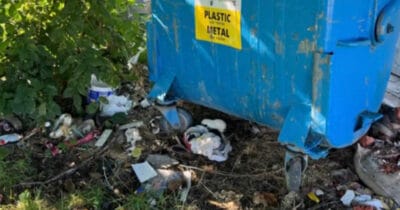
Many people enjoy eating lobster. Go to a local seafood restaurant or supermarket and you may find a tank full of recently-caught and still-alive lobsters, ready to be picked out and cooked fresh.
But one Long Island supermarket ended up with an extremely rare catch: a 1-in-30-million orange lobster, up for sale for anyone looking for a fancy meal. But as word spread, one group stepped in to give this rare crustacean a second chance…
If you shopped at the seafood section of the Stop & Shop in Southampton, New York this summer, something unusual might’ve caught your eye in the lobster tank.
Among the batch of regular brown lobsters for sale was an orange lobster. Only about one in 30 million lobsters are naturally orange, making this one very rare crustacean — and yet, he was scooped up with the other lobsters and arrived as part of a shipment before July 4.
According to a Facebook post from Humane Long Island, the orange lobster became something of a celebrity at the Stop & Shop. She was nicknamed “Clementine” and fed shrimps by the store staff.
Not wanting to see Clementine become someone’s dinner, the staff tried to donate her to the local Long Island Aquarium. But the aquarium rejected the request, putting Clementine’s life back in limbo.
But then, the Southampton Animal Shelter Foundation heard about the rare lobster and contacted Humane Long Island, who came up with a plan to release Clementine back into the wild.
Consulting a veterinarian, they moved the lobster to a cold saltwater tank to reacclimate her to the sea. Then when the time was right, they released her into the Long Island Sound, and she disappeared into the ocean depths.
It’s a happy ending for Clementine. But while this lobster generated plenty of headlines and public love due to her unusual color, Humane Long Island urged people to have the same sympathy for the billions of normal-looking lobsters that get caught and eaten every year.
“Lobsters are sensitive, intelligent animals who can travel as far as 100 miles or more each year. Like all aquatic animals, lobsters will pain and suffer when taken from their ocean homes to be eaten or confined to cramped aquariums,” said John Di Leonardo, anthrozoologist and executive director of Humane Long Island.
“Humane Long Island urges everyone to celebrate Clementine’s successful journey back to the wild by respecting all lobsters and not eating them, because no compassionate person should boil an animal alive.”

The vast majority of lobsters are naturally brown, but color variations happen in rare cases: Blue lobsters have a 1-in-2-million occurrence, yellow lobsters roughly 1-in-30-million. The rarest variations are the “cotton candy” or pastel lobster and the white/albino lobster, both with an occurrence of just 1-in-100-million.
(That bright red color we often associate with the species only comes after they’re cooked, regardless of what hue they were when they were alive.)

But not all of these unique lobsters get set free. Some end up in aquariums — like an orange lobster named Crush, who was found at a Red Lobster restaurant in Denver in July — and some just end up eaten.
It’s so rare to see an orange lobster, we are glad that Clementine was spared from the pot and now has a second chance after being released into the wild!
Please share this story! 🧡






